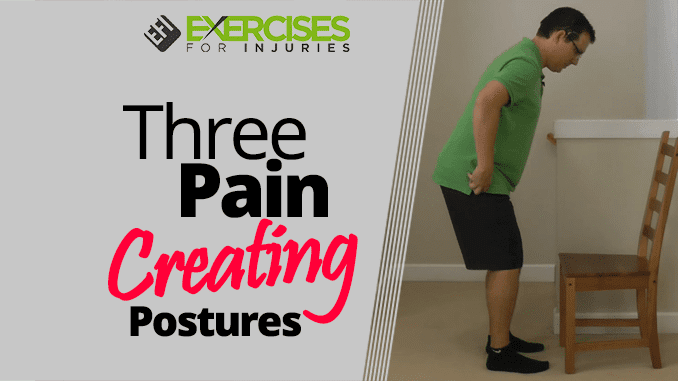
We sit too long, stand too long, and walk too long. These things can lead to back pain, posture, joint pain, and more. But it’s not just a back problem. Our posture is something we either have or don’t have.
Unless you are new to ergonomics and musculoskeletal health or wellness, you probably know that your posture can significantly affect how you feel, positively and negatively.
But what exactly is posture? It’s simply how we hold our bodies in different positions. Awareness of your posture is one way to improve your health, reduce chances of injury, and increase confidence. In this blog post, we will discuss three pain in creating a posture and how you can change your life for the better by retraining your body to maintain good posture all day long!
CLICK HERE to watch this on YouTube
Pain Posture 1. Sitting
Sitting is the first position that can cause pain and injury.
Your neck, back, shoulders, and neck are all subject to more significant stress when you sit at work, drive, watch TV, or sit down for coffee.
Sitting puts about 40% more pressure on your lower back.
If you don’t have the ideal posture, it will only increase. This is especially true if your head is raised or your shoulders are rolled forward.
You might think that standing or walking would be the worst posture offenders, but you would be wrong. Research shows that when you sit for longer than 6 hours, you could be putting your health at risk. Extended periods of sitting wreak havoc on our bodies, especially our backs.
Standing and walking aren’t always options because people are often stuck in an office setting or a customer-facing job. Your posture can still fall apart even if you sit on standing or walking desk. When you’re sitting, you should try to keep your back straight, and your lower back should maintain a slight curve. If your lower back is completely flat, your upper back will be rounded.
To avoid this, sit up straight, and place your feet firmly on the floor, not crossed. Avoid leaning on your desk, and take regular breaks from sitting.
Pain Posture 2. Flexed Lower Back
The second position is to be in a position where you are flexed at the lower back.
Flexed lower back posture is caused by the pelvis tilting forward and the lower back rounding. This happens because of poor posture and is usually accompanied by a forward head posture and a lack of upper body (shoulder) and core strength.
Sitting improperly (with poor posture) can put a ton of strain on your lower back and spine. Since your body weight is distributed differently when sitting down versus standing, it’s even more critical to ensure that you sit up straight when you’re in an office chair.
Sitting for long periods (especially with bad posture) can also weaken your muscles and make it harder for them to support your body.

The problem is the rounded forward position in the low back. Your lower back | 404 can be rounded when you sit. You could be sitting more upright than you should, which can cause a lot of strain and stress to your low back.
Exercise is another time when your lower back may round. You might move towards the back instead of your hips when you exercise. Another familiar moment is when you are standing while your abdominal area is relaxed.
Pain Posture 3. Twisting to the Side
The third is standing, twisting to one side.
Twisting to the side posture happens when you rotate one shoulder forwards and the other backward. This can happen for several reasons, including stress or imbalances in strength between your muscles. As with most posture problems, it can also be caused by poor habits.
For example, you might have a twisted posture if you’re reading a book while lying down and craning your neck. If you work in an office and sit at a computer all day, poor sitting posture is likely to interfere with your posture too.
Twisting to the side can cause several health issues. For instance, it can strain the muscles and ligaments around your spine. This can increase your risk of injury and cause back pain. Twisting to the side can also make it difficult for you to engage your core muscles. This can then cause you to slouch forwards when you stand and walk.

This could be a workout done at the gym, similar to a med ball rotation. Twisting in your back can cause a high spine load.
When you sit down, you can twist your back and turn while using the computer or reaching for the phone. As you move through the day, check to see if these positions are being adopted. They could be causing you pain.
Please take the necessary steps to minimize or eliminate them. If you do, your body and pain will be happier.
4. Bottom line
Bad posture can cause discomfort, fatigue, and even pain. Correcting your posture is essential so that you don’t cause irreversible damage to your body. It’s also critical to your self-esteem. You want to walk around with your head high and feel good about your appearance.
There are many ways to promote better posture, like stretching and strengthening the muscles in your back and shoulders and changing your posture habits. You can walk around with a new, more confident posture with a few minor changes.


